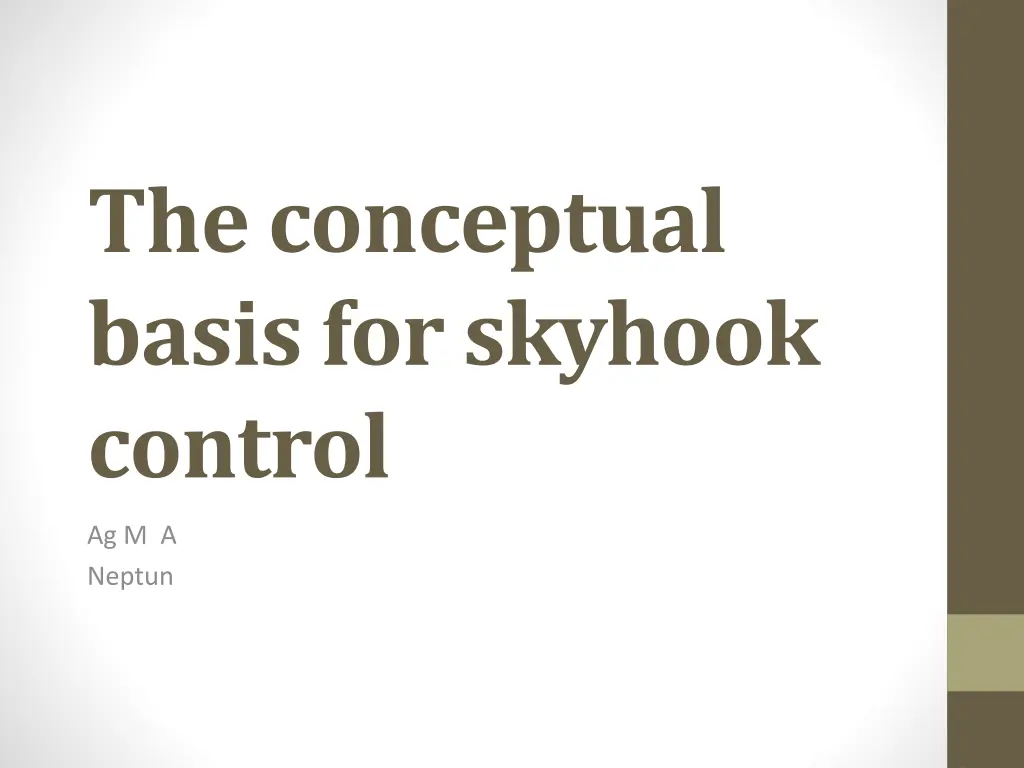
Overview of Skyhook Control and MR-Fluid in Suspension Systems
Discover the innovative concepts behind skyhook control and magnetorheological fluids in automotive suspension systems. Learn about the applications, benefits, and working principles of these advanced technologies that enhance vehicle performance and comfort.
Uploaded on | 0 Views
Download Presentation

Please find below an Image/Link to download the presentation.
The content on the website is provided AS IS for your information and personal use only. It may not be sold, licensed, or shared on other websites without obtaining consent from the author. If you encounter any issues during the download, it is possible that the publisher has removed the file from their server.
You are allowed to download the files provided on this website for personal or commercial use, subject to the condition that they are used lawfully. All files are the property of their respective owners.
The content on the website is provided AS IS for your information and personal use only. It may not be sold, licensed, or shared on other websites without obtaining consent from the author.
E N D
Presentation Transcript
The conceptual basis for skyhook control Ag M A Neptun
Content MR-Fluid Overview Characteristics Utilisations Passive and Active suspension Skyhook control
OverviewMR fluid The discovery of MR fluids is credited to Jacob Rabinow in 1940 damper filled with magnetorheological fluid, which is controlled by a magnetic field, usually using an electromagnet. Continuously controlled by varying the power of the electromagnet
MR-Fluid A magnetorheological fluid (MR fluid) is a type of smart fluid in a carrier fluid, usually. Under a magnetic field, the fluid greatly increases its apparent viscosity, to the point of becoming a viscoelastic solid.
Mr fluid The MR effect is immediately reversible if the magnetic field is reduced or removed. Response times of 6.5 ms have been recorded.
Application of MR-Fluid dampers, shock absorbers, rotary brakes, clutches, prosthetic devices, polishing and grinding devices semi-active control devices
Suspension system Active suspension is a type of automotive suspension that controls the vertical movement of the wheels relative to the chassis or vehicle body with an onboard system, rather than in passive suspension where the movement is being determined entirely by the road surface, Skyhook theory is the theory that active suspension systems are targeting.
Active vs Passive suspension https://www.youtube.com/watch?v=ket6bDuzoVQ
Skyhookdamper While the vehicle is in motion, the sensors supply all the information including braking and road speed signals which the ECU needs in order to produce optimum damping effort. The ECU then controls individual damping action to each wheel separately in accordance with parameters stored in the software. https://www.youtube.com/watch?v=W5zblLY4R3Y
SkyhookControl - Passive Damping : We can derive the transmissibility of the passive seat suspension as:
SkyhookControl -Passive suspension At low passive damping ratios, the resonant transmissibility (around = n) is relatively large, while the transmissibility at frequencies above the resonant peak is quite low. The opposite is true for relatively high damping ratios. Passive suspension Transmissibility
Ideal Skyhook Control Notice : that this is a purely fictional configuration, since for this to actually happen, the damper must be attached to a reference in the sky that remains fixed in the vertical direction, but is able to translate in the horizontal direction.
Ideal Skyhook Control As in the passive case, as the skyhook damping ratio increases, the resonant transmissibility decreases. Increasing the skyhook damping ratio, however, does not increase the transmissibility above the resonant frequency. For sufficiently large skyhook damping ratios (previous ex : >0.707), we can isolate even at the resonance frequency.
Skyhook Control Passive suspension Transmissibility Ideal skyhook suspension Transmissibility
Semi-active dampers One method of generating the skyhook damping force is to remove the passive suspension, both the damper and the spring, and replace it with an active force generator.
Conclusion MR dampers offer an attractive solution to energy absorption in mechanical systems and structures and can be considered as fail-safe devices
